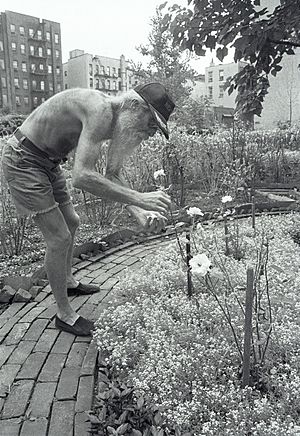Adam Purple facts for kids
Quick facts for kids
Adam Purple
|
|
|---|---|

Adam Purple tending his Urban Garden in 1984
|
|
| Born |
David Lloyd Wilkie
November 10, 1930 Independence, Missouri, U.S.
|
| Died | September 14, 2015 (aged 84) New York City, New York, U.S.
|
| Occupation | Activist |
Adam Purple (born David Lloyd Wilkie; November 10, 1930 – September 14, 2015) was a famous activist and "Guerrilla Gardener" in New York City. He was best known for creating his amazing "Garden of Eden." His real name was David Lloyd Wilkie, but he used many other names, including Adam Purple.
Contents
Early Life and Education
Adam Purple was born David Lloyd Wilkie in Independence, Missouri, in 1930. He was one of seven children. His father worked with machines and wood, and his mother was a seamstress and gardener.
Adam served in the U.S. Army. He later earned a master's degree in journalism from the University of Missouri. He taught at high schools and colleges in California and South Dakota. In 1968, he moved to New York City.
Creating the Garden of Eden
Adam Purple's most famous project was his "Garden of Eden." He built this large community garden all by himself over five years, starting in 1975. It was located on Forsyth Street in the Lower East Side of Manhattan.
The garden began when the area was run down and empty lots were common. Adam decided to plant something with his friend. They only used hand tools to clear the land. He even brought horse manure from Central Park to make the soil super rich.
The garden was ready for planting in the spring of 1975. It was designed with cool concentric circles, like a target, and a yin-yang symbol in the middle. As more buildings were torn down nearby, Adam added new rings to his garden.
By the end, the garden was huge, covering about 15,000 square feet. It grew many different foods, like corn, cucumbers, tomatoes, and strawberries. It also had 45 trees, including black walnut trees.
The Garden's End and Legacy
In the early 1980s, the city planned to build new homes on the land where the garden stood. Many people, including neighborhood activists, tried to save the garden. Some even created new designs that would include the garden in the housing plan.
However, these efforts were not successful. On January 8, 1986, a judge ruled that the garden could be torn down. It took only 75 minutes for large construction vehicles to destroy the "Garden of Eden."
Even after the garden was gone, Adam Purple was remembered. His friend, artist George Bliss, painted purple footprints around the Lower East Side. These footprints led to where the garden used to be. Adam Purple was also featured in a book of photographs called Harvey Wang's New York. He was truly a unique and memorable person in New York City.
Death
Adam Purple died on September 14, 2015. He was 84 years old. He passed away from a heart attack while riding his bicycle across the Williamsburg Bridge.
See also
- Max Cantor
- Rivington School

